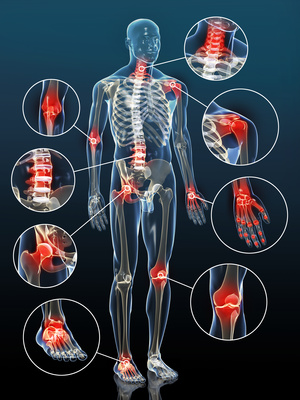Arthritis Treatments
Arthritis is a general term that covers over 100 different conditions that affect the musculoskeletal system. These joint-related problems cause symptoms such as stiffness, inflammation, pain, and damage to the cartilage and surrounding tissues. This can lead to weakened joints, deformities, and instability that can make basic daily tasks challenging. That is why we need arthritis treatments to help ease these symptoms.
In the UK approximately 10 million people suffer from arthritis, with the most common forms being osteoarthritis and rheumatoid arthritis. There are no cures for these conditions. However, there are ways to manage arthritis to lessen the symptoms and improve the quality of life. Arthritis treatments vary and often include a combination of medications, natural supplements, physical therapy, and lifestyle adjustments.
Classification of Arthritic Conditions
The wide range of arthritis conditions can be classified into three main groups:
Inflammatory Arthritis
Inflammatory arthritis is a term used to describe a group of conditions which affect the immune system. The arthritis is caused by the body’s own defence system attacking its own tissues instead of viruses, germs and other foreign substances. This causes stiffness, pain and joint damage.
The most common type of inflammatory arthritis is Rheumatoid Arthritis (RA). Other common conditions from within this category include gout, ankylosing spondylitis, and psoriatic arthritis.
 Non-Inflammatory Arthritis
Non-Inflammatory Arthritis
Non-Inflammatory Arthritis is characterized by natural wear and tear of mostly the weight-bearing joints (back, hip, feet and knee). It can also affect both the smaller joints of the body, including the hands and wrists.
Unlike Rheumatoid Arthritis, this type of arthritis is very common in elderly people.
The most common type of Non-Inflammatory Arthritis is osteoarthritis. Other conditions within this category include scoliosis and torn ligaments.
Connective Tissue Disease
This category includes Sjogren’s syndrome, lupus, and sclerosis.
Types of Arthritis Treatments
The treatment of arthritis aims to minimize symptoms so that joint health is improved. Using a range of therapies, patients can reduce inflammation, pain, and swelling to improve mobility and slow the progression of joint degradation.
The best arthritis treatments will include a combination of approaches, varying depending on individual conditions. For example, a psoriatic arthritis treatments may differ from an osteoarthritis treatment plan due to differences in the underlying cause of the joint degradation.
Arthritis Treatment Requires Lifestyle Adjustments
If left untreated conditions such as rheumatoid arthritis and osteoarthritis will significantly worsen as the joint degradation accelerates. In order to preserve quality of life it’s essential to make positive lifestyle adjustments.
This includes maintaining an arthritis-friendly diet, rich in anti-inflammatory foods and antioxidants.
The Importance of Diet and Nutrients
Making smart food choices can significantly improve joint health, reducing inflammation and associated pain to make movement easier. This will lessen joint swelling and stiffness, providing better joint mobility.
Routinely taking appropriate effective joint food supplements can also significantly reduce arthritis symptoms. The high-street and online market is awash with so-called “joint food” supplements.
But be careful, the products differ significantly in quality and value for money. We have taken the guesswork out for you and compared over 20 joint food supplements.
Regular participation in low impact sports is also an important aspect of an arthritis treatment plan. Low-impact exercise such as swimming, rowing, cycling, yoga, bowling and golfing will help to maintain joint movement, reduce joint instability and help to minimise pain.
Of course, regular (ideally outdoor) exercise also increases your endorphine levels and helps to keep your body weight in check. This reduces general pressure on your joints keeping you happy and healthy.
References
- “Crowson, C. et.al. (2011). The lifetime risk of adult-onset rheumatoid arthritis and other inflammatory autoimmune rheumatic diseases. Arthritis and Rheumatology, Volume 63, Issue 3, (pp. 633-9).” ↩
- “Schipper, L. et.al. (2012). A tight control treatment strategy aiming for remission in early rheumatoid arthritis is more effective than usual care treatment in daily clinical practice: a study of two cohorts in the Dutch Rheumatoid Arthritis Monitoring registry. Annuals of Rheumatic Diseases, Volume 71, Issue 6, (pp. 845-50).” ↩
- “Demoruelle, M. and Deane, K. (2012). Treatment strategies in early rheumatoid arthritis and prevention of rheumatoid arthritis. Current Rheumatology Reports, Volume 14, Issue 5, (pp. 472–480).” ↩
- “Allaart, C. and Huizinga, T. (2011). Treatment strategies in recent onset rheumatoid arthritis. Current Opinions in Rheumatology, Volume 23, Issue 3, (pp. 241-4).” ↩
- Schipper, L. and van Riel, P. (2011). Ups and downs in the treatment strategies of rheumatoid arthritis. Rheumatology, Volume 50, Issue 5, (pp. 818-20).” ↩
- “Breedveld F. and Combe, C. (2011). Understanding emerging treatment paradigms in rheumatoid arthritis. Arthritis Research & Therapy, Volume 13, Issue 1.” ↩
- “VanItallie TB (October 2010). “Gout: epitome of painful arthritis”. Metab. Clin. Exp. 59(Suppl 1): S32–6. doi:10.1016/j.metabol.2010.07.009. PMID 20837191″ ↩
- “Puttini, P. et.al. (2005). Osteoarthritis: an overview of the disease and its treatment strategies. Seminars in Arthritis and Rheumatiodism, Volume 35, Issue 1, (pp. 1-10).” ↩
- “Verdecchia, P. et.al. (2010). Treatment strategies for osteoarthritis patients with pain and hypertension.” Therapeutic Advances in Musculoskeletal Disease, Volume 2, Issue 4, (pp. 229-40).” ↩
- “Itoh, K. et.al. (2008). A pilot study on using acupuncture and transcutaneous electrical nerve stimulation (TENS) to treat knee osteoarthritis (OA). Chinese Medicine, Volume 3, Issue 2.” ↩
- “Zhang, W. et.al. (2010). OARSI recommendations for the management of hip and knee osteoarthritis: part III: changes in evidence following systematic cumulative update of research published through January 2009. Osteoarthritis and Cartilage, Volume 18, Issue 4, (pp. 476-99).” ↩
- “Denegar, C. et.al. (2010). Preferences for heat, cold, or contrast in patients with knee osteoarthritis affect treatment response. Clinical Interventions in Aging, Volume 5, (pp.199-206).” ↩
- “Turley, M. et.al. (2006) Non-fatal disease burden associated with excess body mass index and waist circumference in New Zealand adults. Australian and New Zealand Journal of Public Health, Volume 30, Issue 3, (pp. 231-237).” ↩
- “Gruenwald et al. (2009). Effect of glucosamine sulfate with or without omega-3 fatty acids in patients with osteoarthritis. Advances in Therapy, Volume 26, Issue 9, (pp.858-71).” ↩
- “Henrotin et al. (2010). Chondroitin Sulfate in the Treatment of Osteoarthritis: From in Vitro Studies to Clinical Recommendations. Therapeutic Advances in Musculoskeletal Diseases, Volume 2, Issue 6, (pp. 335-48). ↩
- “Beer, A. & Wegener, T. (2011). Vitamin E for gonarthrosis and coxarthrosis – results of a postmarketing surveillance study. MMW Fortschritte der Medizen, Volume 153, Supplement 1, (pp. 14-20).” ↩
- “Belcaro, G. et al (2008). Treatment of osteoarthritis with Pycnogenol. The SVOS (San Valentino osteo-arthrosis Study). Evaluation of signs, symptoms, physical performance and vascular aspects. Phytotherapy Research, Volume 22, Issue 4, (pp. 518-23).” ↩

 Dietary supplements containing methylsulfonylmethane have been used in the United States for quite some time. Nonetheless, there have been no clinical studies researching the effects of this sulfone prior to 2006.
Dietary supplements containing methylsulfonylmethane have been used in the United States for quite some time. Nonetheless, there have been no clinical studies researching the effects of this sulfone prior to 2006.




